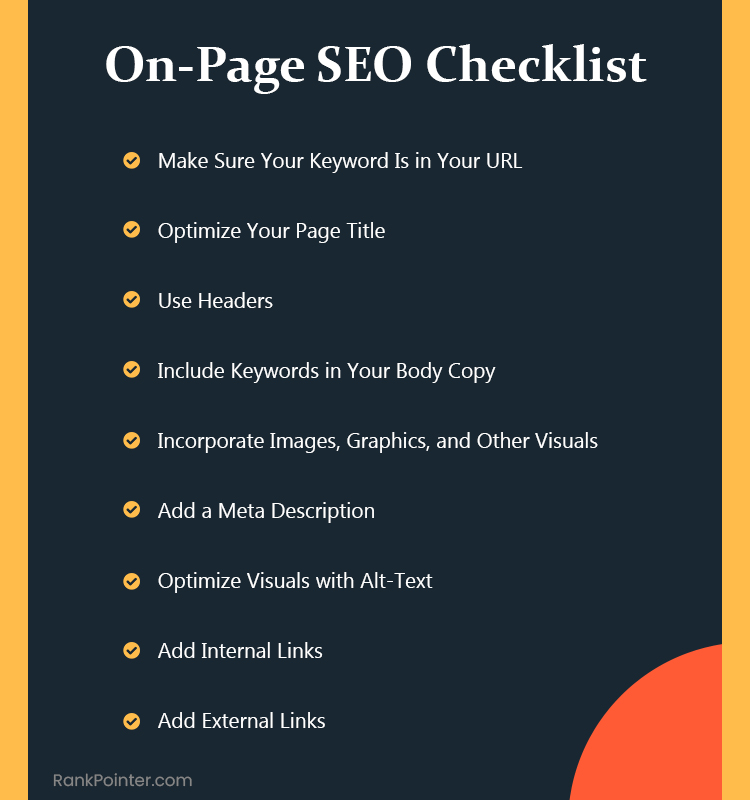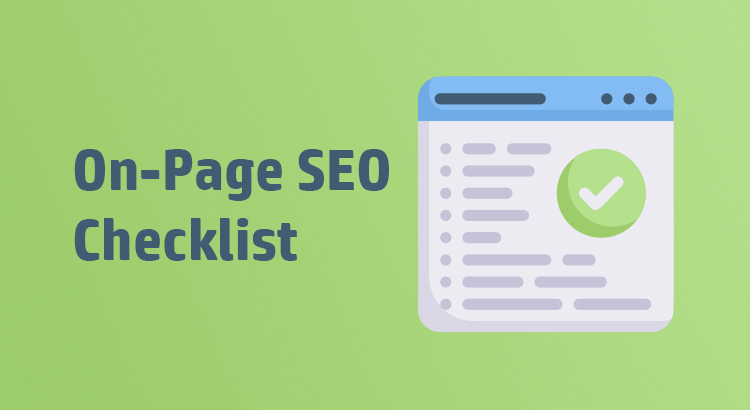On-page SEO holds immense potential to attract numerous new visitors and potential customers directly to your website. Moreover, it empowers you with complete control as you determine the page’s topic, goal, target audience, and keywords. While this may feel both intimidating and empowering, this on-page checklist is available to assist you in getting started confidently.
On-Page Optimization Checklist
The checklist for on-page SEO efforts is given below.
1. Make Sure Your Keyword Is in Your URL
Ensure your URL incorporates your target keyword, signaling the content to users and search engines. Here are some tips for crafting SEO-friendly URLs:
- Remove extra, unnecessary words.
- Limit keywords to one or two.
Consider using HTTPS, as Google now views it as a positive ranking factor.
Learn More: URL SEO: How to Create SEO-Friendly URLs
2. Optimize Your Page Title
Craft a descriptive title that includes your target keyword and accurately describes the page’s content. Here are some best practices for developing a page title:
- Keep it under 60 characters (per Google’s update) to ensure that your titles display correctly. Although Google doesn’t have an exact character limit, its display titles max out at 600 pixels. Keeping your titles at 60 characters or less ensures the title won’t be cut off in search results.
- Avoid stuffing the title with keywords.
- Refrain from using all caps.
- Include your brand in the title.
3. Use Headers
Organize your content with header tags to make it more scannable and search-engine friendly.
Be sure to naturally incorporate important keywords in your headers, but choose different ones than what’s in your page title. Place your most important keywords in your <h1> and <h2> headers.
4. Include Keywords in Your Body Copy
In addition to your URL, title, and headers, ensure to incorporate your keyword throughout your web page(s). Sprinkle your keyword naturally within your content.
While keywords are essential for SEO, it’s crucial to avoid keyword stuffing. This practice, involving excessive repetition of keywords or phrases to manipulate search engine rankings, can be detrimental to your website’s SEO.
Not only does keyword stuffing create a spammy reading experience, but modern search engines are adept at detecting and penalizing such tactics.
5. Incorporate Images, Graphics, and Other Visuals
Enhance your content with captivating and relevant visuals to alleviate large blocks of text and enhance visual appeal. Visual elements also aid in attracting potential image search traffic.
To optimize images for on-page SEO, ensure proper compression for faster loading, utilize descriptive filenames, and provide informative alt tags.
These practices not only improve user experience but also enhance the visibility of your web pages in search engine results.
Related Article: The Power of Visuals: Are You Igniting Your Content?
6. Add a Meta Description
Write a compelling meta description that concisely summarizes the page’s content and entices users to click through from search results.
Here are key points for an effective meta description:
- Keep it under 160 characters, although Google may allow longer descriptions. Include your entire keyword or keyword phrase.
- Use a complete, engaging sentence or two.
- Avoid alphanumeric characters like —, &, or +.
7. Optimize Visuals with Alt-Text
Ensure your visual content is optimized by adding descriptive and specific alt-text to images. Include your keyword in the alt text to enhance the page’s SEO and potential ranking in image search results.
Consider the following when adding image alt-text:
- Make it descriptive and specific.
- Ensure it is contextually relevant to the broader page content.
- Keep it under 125 characters.
- Use keywords sparingly to avoid keyword stuffing.
Read More: Image Optimization in SEO: Tips and Best Practices for Better Ranking
8. Add Internal Links
Improve the discoverability and understanding of your website’s pages by incorporating internal links into your content. Follow these steps to add internal links effectively:
- Identify relevant anchor text: Choose descriptive anchor text that accurately represents the linked page’s content.
- Identify the target page: Select a page that offers additional value or information related to the current content.
- Place links strategically: Ensure the links are contextually relevant and enhance the user experience. Avoid excessive linking to prevent it from appearing spammy.
9. Add External Links
Even though internal linking is vital for on-page SEO, don’t forget about external links. Incorporating links to credible and trustworthy external sites can enhance your page’s credibility in the eyes of Google and your visitors.

Wrapping Up: On-Page SEO Checklist
By following this comprehensive on-page SEO checklist, you can optimize your website effectively and improve its visibility in search engine results.


